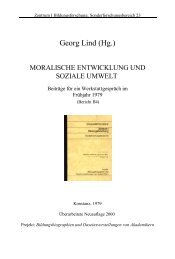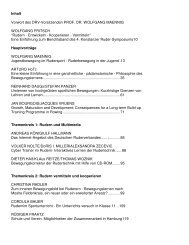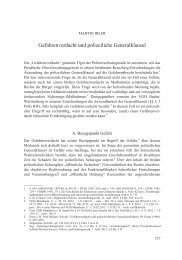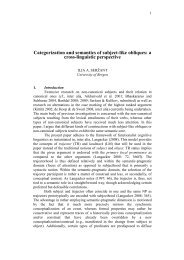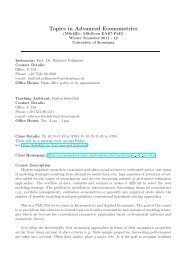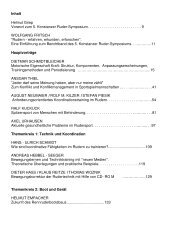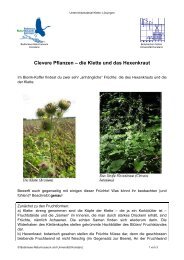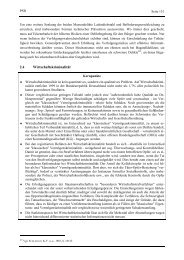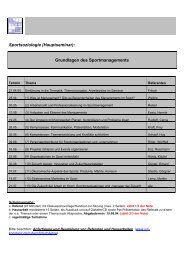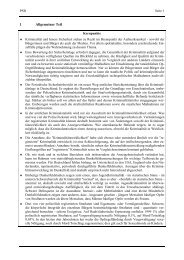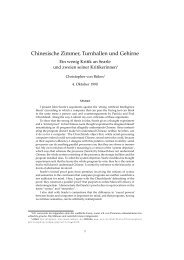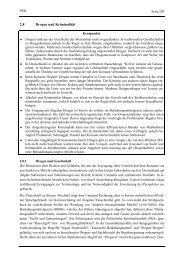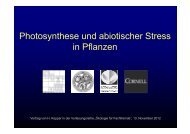Book of Abstracts Book of Abstracts - Universität Konstanz
Book of Abstracts Book of Abstracts - Universität Konstanz
Book of Abstracts Book of Abstracts - Universität Konstanz
Create successful ePaper yourself
Turn your PDF publications into a flip-book with our unique Google optimized e-Paper software.
A - 23<br />
132<br />
Surface Entropy <strong>of</strong> Argon Clusters<br />
Mikael Kjellberg, Sergey Prasalovich, Vladimir Popok, Klavs Hansen, Eleanor E. B. Campbell<br />
Department <strong>of</strong> Physics, Göteborg University, SE-41296 Göteborg, Sweden<br />
The enhanced stability <strong>of</strong> certain cluster sizes is traditionally inferred from the enhanced<br />
abundance <strong>of</strong> these species in mass spectra. For rare gas clusters, the stability pattern can be<br />
described as due to a close packing <strong>of</strong> atoms into closed structures (shells) with the symmetry <strong>of</strong><br />
Mackay icosahedra. The mere presence <strong>of</strong> shell closings does not give any information on the<br />
magnitude <strong>of</strong> the energies involved. A quantitative comparison requires knowledge <strong>of</strong> the<br />
binding energies <strong>of</strong> the clusters. It is possible to extract this information from the mass spectra<br />
by making reasonable general assumptions [1] with the restriction that only relative values can<br />
be found. The flat abundance spectrum (after background subtraction) is related to relative<br />
I ∝ D + C D − D G.<br />
energies as ( )<br />
N N+ 1 v N N+<br />
1 /<br />
This has been done in Fig 1(A) for masses around the N = 55 “magic number”. The amplitude<br />
in the relative energy variations does not follow the same trend as the local abundance<br />
variations. In particular the maximum in the relative energy is shifted to smaller N. The reason<br />
for this is that the relative energies obtained in this procedure are not the dissociation energies,<br />
DN, <strong>of</strong> the clusters but the free energies, FN = DN – TSN, where SN is identified with the surface<br />
entropy (the natural logarithm <strong>of</strong> the number <strong>of</strong> ways the configurational ground state can be<br />
contructed). This can be estimated from the structures calculated by Northby [2] and used to<br />
extract the dissociation energies. This is shown in Fig. 1(B) and compared with the calculated<br />
dissociation energies, where the absolute scale was obtained by scaling with the bulk and<br />
surface energy. The agreement <strong>of</strong> the trend in the values is very satisfactory.<br />
∆F (meV)<br />
80<br />
75<br />
70<br />
65<br />
60<br />
Figure 1. A, Left:Integrated peak intensities from Ar N + mass spectrum filled squares, (right y-axis) and the<br />
dissociation energies extracted from the spectrum (free energies) (open squares, left y-axis). B, Right: Extracted<br />
dissociation energies (free energies) (open circles), dissociation energies after subtraction <strong>of</strong> the entropy term (open<br />
squares), calculated energies from Northby [2] (filled squares).<br />
References<br />
50 51 52 53 54 55 56 57 58 59 60<br />
0<br />
61<br />
N<br />
[1] K. Hansen and U. Näher, Phys. Rev. A , 60 1240 (1999).<br />
[2] J.A. Northby, J. Xie, D.L. Freeman, J.D. Doll, Z. Phys. D 12 69 (1989)<br />
∆F<br />
I N<br />
3<br />
2<br />
1<br />
I N<br />
Energies [meV]<br />
85<br />
80<br />
75<br />
70<br />
65<br />
60<br />
55<br />
50<br />
45<br />
∆F N,exp<br />
D N,exp<br />
D N,Northby<br />
50 52 54 56 58 60<br />
N



